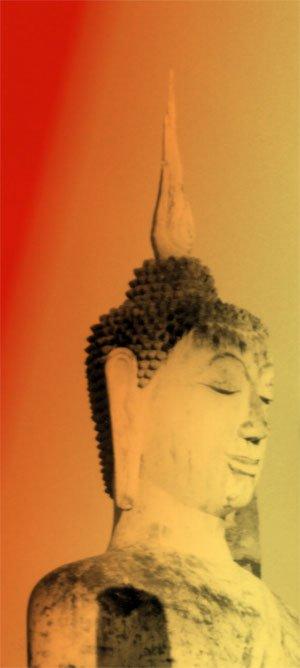Editor’s note: This feature was first published in the now-retired Bodhi Journal, Issue 14, December 2009.
?sava(s) together with latent tendencies (anusaya), fetters (sa?yojana) and hindrances (n?vara?a) constitute the unwholesome cognitive and emotive aspect of mind. [1] What bind beings in the cycle of sams?ra are these unwholesome psychological contents eradication of which brings about the absolute peace of mind (nibb?na).
The term ?sava is formed with the prefix ? and the verbal root √sru (to flow). Literally it means ‘that which flows (out or on to)’, ‘outflow’ & ‘influx’. [2] Different scholars give different renderings of the term into English. Some of the renderings are: ‘cankers’, ‘taints’, ‘corruptions’, ‘intoxicant biases’ [3], ‘ideas which intoxicate the mind’ [4] etc.
?sava is such an important topic that the discussion of it occupies a number of passages in the entire P?li canon. In most cases it is discussed as an unwholesome mental constituent that intoxicates the mind of beings and thus they are unable to rise themselves to higher things. It is some kind of unwholesome mental force that exists in the mind of unenlightened men. And it flows out to the external world through the six (sense) organs of the body. Thus it makes people ‘losing the way and falling into the cycle of birth and death’. [5]
?sava(s) are compared to a swift stream into which all unenlightened beings are being drifted away. To get rid of the stream one must get onto the raft of dhamma. P?li canon mentions of various ways following which one can get rid of ?sava(s). We shall discuss those ways later. Before that we shall know what those ?sava(s) are. The passages in the P?li canon frequently mentions of three ?sava(s), namely; (1) k?m?sava – canker of sense desire, (2) bhav?sava – canker of existence, and (3) avijj?sava – canker of ignorance. [6] There is also a list of four?sava(s). In this list the one that is added is di??hi-?sava – the canker of views. [7] Scholars [8]are of the opinion that the list of three is probably older than that of the four.
?sava(s) are sometimes compared to kilesa for they contribute to defile the thoughts of beings and thus produce evil. They are also enumerated in the sense of fetter for they tie beings down and keep them from enjoying the true freedom of mind. And as it is mentioned above ?sava(s) are also to be understood as a swift stream or flood (ogha) for they carry beings away in the ocean of sa?s?ra.
Some of the many ways mentioned in the Tipi?aka to overcome ?sava(s) are briefly presented below. The ?sava(s) could be overcome by ‘reflecting on the loathsomeness of the body, food etc. and contemplating on impermanence and death’. [9] They could also be overcome by ‘following the noble eightfold path’ [10]; ‘cultivating five spiritual faculties’ [11]; ‘practicing mindfulness of breathing’ [12] etc. However, the most effective way to overcome ?sava(s) is through the understanding of four noble truths.
The Buddha says “the destruction of canker is for him who knows and sees, not for him who does not know and see.” [13] Thus in the Sabb?sava Sutta of Majjhimanik?ya and the ?sava Sutta of A?guttaranik?ya, seven ways of eradicating cankers are systematically enumerated. It is interesting to note that in both the discourses ?sava(s) are explained totally from a different perspective than the ?sava(s) mentioned above. From the description of ?sava(s) in these two discourses we know that in our everyday life we always encounter ?sava(s). The discourses also provide us with appropriate methods of overcoming those ?sava(s) which we will discuss in the subsequent paragraphs of the essay.
The seven ways of overcoming ?sava(s) are given below. ?sava(s) should be abandoned (1) by seeing, (2) by restraining, (3) by proper use, (4) by enduring, (5) by avoiding, (6) by removing and (7) by developing. The statement that ‘the destruction of ?sava(s) is for him who knows and sees and not for him who does not know and see’ demonstrates that if anyone is not aware of his present being it is not possible for him to destroy ?sava(s). Not just being ordinarily aware of one’s own being but being aware with wise attention (yoniso manasik?ra). In other word being aware of one’s own being with unwise attention (ayunoso manasik?ra) is not encouraged. Because by doing so one’s unarisen cankers (of sensual desire, of being and of ignorance) arise and arisen cankers develop.
A man who attends to things unwisely is an untaught ordinary person, who has no regard for the noble ones or true men. He is unskilled and undisciplined in dhamma. Such a person is indeed ignorant of the real nature of existence as impermanence, unsatisfactory and non-substantiality. Having no knowledge about the three fundamental characteristics of existence he dwells in complete illusion (moha/m?y?). He regards impermanent as permanent, suffering as happiness, non-substantiality as substantiality and impure as pure. This happens due to the absence of correct vision regarding the real nature of existence which is to be understood asavijj?sava in this context. The grossest illusion in the life of a man is ‘believing in the existence of self’ (sakk?yadi??hi). Venerable Nyanatiloka in his Buddhist Dictionary says, “(the view that) has most misled and deluded mankind is the personality-belief, the ego-illusion”.[14] This ego-illusion mainly is of two kinds, namely; (1) eternity belief – sassatadi??hi, and (2) annihilation belief – ucchedadi??hi.
However, in the Sabb?sava Sutta the ego illusion is explained to be manifested in 16 ways in the mind of beings. As for example the individual thinks; ‘was I in the past? was I not in the past? what was I in the past? how was I in the past? having been what, what did I become in the past?’ etc. Thus he thinks in the same way with regard to his future and present being. When he thinks in this way there arises in him one of following six views. They are:
1. Self exists for me
2. No self exists for me
3. I perceive self with self
4. I perceive not self with self
5. I perceive self with not self and
6. It is this self of mine that speaks and feels and experiences here and there the result of good and bad actions; but this self of mine is permanent, everlasting, eternal, not subject to change, and it will endure as long as eternity.
These are all speculative views that arise in the mind of beings due to ignorance and unwise attention. The Buddha says, “This speculative view, bhikkhus, is called the thicket of views, the wilderness of views, the contortion of views, the vacillation of views, the fetter of views.” [15]The untaught ordinary beings wander about in the sa?s?ra experiencing all sorts of agony due to being fettered by the fetter of views. The only way to overcome such fetter as this is by attending wisely to the four noble truths.
As we have seen earlier ?sava(s) are sometimes called ‘outflow’ because they flow out through the six sense organs to the external world and produce evil. This should clearly be understood with reference to the perceptual process enumerated in the Madhupi??ika Sutta [16]. In summary there it says that it is natural that the mind and matter will interact with each other. The six sense organs will come into contact with the six sense objects. The problem occurs when we try to make it personal by putting on our ego-consciousness. When we react with the natural process of perception with our judgmental attitude of either liking or disliking, we subsequently become the helpless victim of the process and thus experience constant agony. The phrase used to describe this aspect of our mind is ‘conceptual proliferation’ – papañca-saññ?-sa?kh?. Therefore, constant guarding of sense doors (indriya-sa?vara) is encouraged by the Buddha.
The next three types of ?sava(s) enumerated in the sabb?sava and ?sava sutta(s) are ?sava(s) that have extreme practical significance in the life of men and that could be eliminated just by being little bit aware of the situation one is in. It is a fact that to survive in life everyone needs the four requisites, namely food, clothing, lodging and medicine. An individual is overcome by ?sava(s) regarding these four requisites when he, forgetting the real purpose, uses them improperly. According to the Buddhist understanding food should be taken to terminate the old feeling of hunger without arousing new feeling. Elsewhere in the canon the moderation (mattaññut?) in eating is also elaborated. Both the overconsumption and fasting are discouraged by the Buddha. Instead the middle way in the consumption of not only food but of everything is explained as an ideal mean which facilitate to the progress of the spirituality. Clothing too is to be used not for the show off (as it is the case for most people) but to protect one’s boy from gadflies, mosquitoes, wind, the sun etc. and also to conceal the private parts. It is the same for lodging and medicine too. They are to be used for leading a healthier life so that the individual can progress in the spiritual path. However, in today’s materially progressed modern world the rich people live a life of extreme luxury, while a great number of poor people suffer from the lack of having four requisites. Thus inequality is an obvious phenomenon in the world.
The next two of the three ?sava(s) are enduring and avoiding. In life we face certain situations which if we are unable to endure or avoid, suffering becomes inevitable for us. The text mentions of things such as; cold, heat, hunger, thirst, creeping things, wild bull, horse, dog, elephant etc. However, besides these unpleasant things, in society we come into contact with people or environment that are not so friendly and act like enemy. In such situation if we have any chance of leaving for more agreeable environment, that is ok, but if we do not have any other option than living in such environment, it is better to endure it without reacting. For we can not alter the situation anyway.
The last two ways of overcoming ?sava(s) are by removing and developing. Certain unwholesome mental factors namely the thoughts of sensuality (k?mavitakka?), of ill-will (vy?p?davitakka?), and of cruelty (vihi?s?vitakka?) are ?sava(s) that should be overcome by removing. And the removal of these unwholesome mental factors is possible with the development of certain wholesome mental qualities. The immediately following and the last way of overcoming ?sava(s) mentioned is the way of developing. What are the wholesome mental qualities should be developed by one? They are the seven factors of enlightenment (satta-bojjha?ga), namely; 1) Mindfulness (sati), 2) investigation of the law (dhamma-vicaya), 3) energy (viriya), 4) rapture (p?ti), 5) tranquility (passaddhi), 6) concentration (sam?dhi), and 7) equanimity (upekkh?). They are called the factors of enlightenment because they, if properly practiced, lead to the enlightenment.
Therefore from the above discussion we come to the conclusion that to lead a peaceful and happy live everybody needs to overcome ?sava(s). We have seen that the Sabb?sava Sutta and the ?sava Sutta very clearly and systematically present the ways to overcome ?sava(s) in our day to day life. The most important thing for one who wishes to overcome ?sava(s) is to be aware of his present being, as the texts say, by ‘knowing’ and ‘seeing’. And the awareness should be accompanied by wise or proper attention. Buddhism always emphasizes on the investigation into the causes of what is happening into and around an individual and act accordingly. For it is his attitude and understanding of nature that determines his experiences – be it good or evil.
Abbreviations:
DN = D?ghanik?ya
MN = Majjhimanik?ya
SN = Sa?yuttanik?ya
AN = A?guttaranik?ya
It = Itivuttaka
Vibh = Vibha?ga
Ps = Pa?isambhidamagga
NBD = Nyanatiloka’s Buddhist Dictionary
PED = Pali English Dictionary (of Rhys Davids)
References:
1. Malalsekera, G.P. (et al, ed.) (1997). Encyclopaedia of Buddhism. Sri Lanka: The Government of Ceylon.
2. Rhys Davids, T.W. and Stede William. (eds.) (1997). Pali and English Dictionary. New Delhi: Asia Educational Services.
3. Ven. Nyanatiloka, 1988 (1952), Buddhist Dictionary (Manual of Buddhist Terms and Doctrines), Kandy: BPS.
4. Buddhadatta, A.P. Concise P?li English Dictionary, Dehiwala: Buddhist Cultural Centre.
You can access the original Bodhi Journal articles in our archive.














